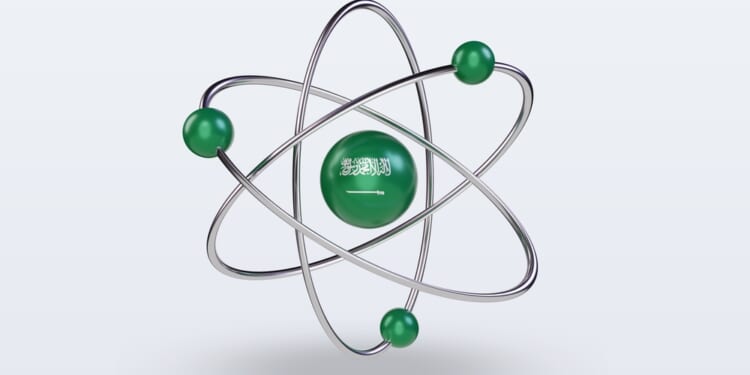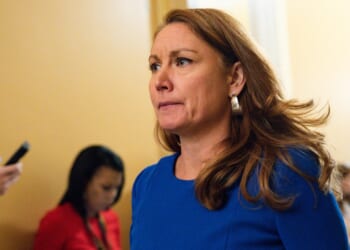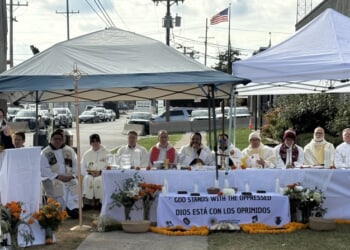Companies from South Korea are among those bidding to help Saudi Arabia build its first large-scale nuclear energy power station.
With Crown Prince Mohammed bin Salman’s visit to Washington approaching on November 18, attention is once again turning to Saudi Arabia’s nuclear energy program. The decision over who will build the Kingdom’s first reactor could potentially shape the region’s energy landscape and test the depth of US coordination with its allies in third-country nuclear exports.
Riyadh is preparing to select a partner for its first large-scale nuclear power station on the Persian Gulf coast, a project central to its Vision 2030 diversification plan. Bids from China, Russia, France, and South Korea are on the table. Among the four, South Korea, formally known as the Republic of Korea (ROK), stands out as a particularly strong contender, not only because of its proven track record in the United Arab Emirates’ (UAE) Barakah project, but also because its reactor technology combines competitive cost, safety, and operational reliability. While the United States has not formally entered the race, its position remains central given the use of US-origin technology embedded in several reactor designs—most notably Korea Electric Power Corporation’s (KEPCO) APR-1400—and the broader implications this holds for US–South Korea coordination in third-country nuclear exports.
Saudi Arabia’s Priorities for the Reactor Tender
For Riyadh, the reactor tender represents a strategic lever for advancing localization, technology cooperation, and innovative financing under Vision 2030. The Kingdom of Saudi Arabia (KSA) seeks a partner prepared to invest jointly, help develop local industrial supply chains, and expand training and research programs that embed technical expertise within Saudi institutions. These priorities reflect a broader ambition to build a resilient nuclear ecosystem that combines international partnership with growing domestic capability.
For Seoul, the Saudi bid offers both a strategic opportunity and a diplomatic test. South Korea has emerged as one of the world’s most competitive nuclear exporters, a track record that makes its participation in the Saudi tender particularly strong. Yet, that opportunity is complicated by Washington’s effort to keep US technology and export controls central to any prospective deal.
For Washington, the stakes are equally high. US policymakers view nuclear cooperation as both a tool of strategic influence and a test of alliance coordination in emerging markets. Tensions over intellectual property rights between Westinghouse and Korea Hydro and Nuclear Power (KHNP) have underscored the need for closer alignment between the United States and South Korea. Should those frictions resurface, Riyadh would be wary of becoming entangled in legal or political disputes between its partners. Conversely, if Saudi Arabia decides to move forward with Seoul’s bid, this visit could become a platform where Washington, Seoul, and Riyadh align on a coordinated framework, integrating technology cooperation, export controls, and long-term regulatory alignment, to turn potential friction into strategic collaboration.
US–South Korea Coordination
During the Asia-Pacific Economic Cooperation (APEC) Energy Ministers’ Meeting in Seoul in late August, US Deputy Secretary of Energy James Danly met with senior Korean officials and representatives from KEPCO to explore closer coordination on the Saudi bid. Washington reportedly encouraged Seoul to promote a US-licensed reactor model, specifically Westinghouse’s AP1000, rather than its own APR-1400, and to consider a joint bid that would align Korean commercial expertise with US export-control requirements.
These discussions are unfolding amid a broader recalibration of US–South Korea civil nuclear cooperation. Seoul and Washington have been holding talks to amend their bilateral Nuclear Cooperation Agreement, an effort that could potentially give South Korea greater flexibility in enrichment and reprocessing, while also opening the door to deeper collaboration on advanced technologies, including, possibly, nuclear-powered submarines, according to Energy Intelligence. Washington’s push for a joint bid in Saudi Arabia thus reflects commercial alignment and an emerging test of strategic trust between the two allies. If these discussions prove fruitful, all parties stand to benefit: from a deal that advances Saudi Arabia’s energy ambitions, strengthens US–South Korea coordination, and offers a model for cooperative nuclear partnerships in the region.
Building Saudi Arabia’s Domestic Nuclear Framework
Parallel to these external developments, Saudi Arabia has been reinforcing its domestic nuclear framework, expanding regulatory capacity, financing mechanisms, and human-capital programs under King Abdullah City for Atomic and Renewable Energy (KACARE) and related institutions.
Advancing Saudi Arabia’s Nuclear Energy Readiness
In a statement released in September 2024 at the sixty-eighth International Atomic Energy Agency (IAEA) General Conference, His Royal Highness (HRH) Prince Abdulaziz bin Salman, Saudi Arabia’s Minister of Energy, announced that Saudi Arabia would rescind its Small Quantities Protocol and implement the full Comprehensive Safeguards Agreement. This decision reflects Saudi Arabia’s intent to advance nuclear technology as part of its energy diversification and objectives under Vision 2030, in close cooperation with the IAEA and the international community. Nuclear energy, in this context, is not merely a technical pursuit but a strategic pillar of Saudi Arabia’s post-hydrocarbon transition.
The Kingdom has articulated a long-term goal of developing up to 17 gigawatts of nuclear generation capacity by 2040, beginning with the construction of its first commercial nuclear power station at Khor Duwaiheen, one of two proposed sites, along with Umm Huwayd, both located on the Arabian Gulf coast near the UAE–Qatar border. This project is expected to provide approximately 2.8 gigawatts of capacity and serves as the flagship large-scale nuclear plant under the Saudi National Atomic Energy Project (SNAEP), overseen by the Ministry of Energy and KACARE. In terms of the regulatory framework, KACARE leads the development of nuclear and renewable technologies, supporting localization, lab infrastructure, and human-capital programs. King Abdulaziz City for Science and Technology (KACST) leads research and scientific cooperation, conducting studies with universities and the Ministry of Energy, and providing upstream research and development (R&D) and analytical support. The Nuclear and Radiological Regulatory Commission (NRRC) is the independent regulator that licenses and oversees compliance across nuclear activities. Together, these entities constitute the backbone of Saudi Arabia’s nuclear governance system, linking research, implementation, and regulatory oversight under a unified national framework.
Localization and Capability Development in Saudi Arabia
A major pillar of Vision 2030 is the localization of talent and technology, an objective that shapes Saudi Arabia’s approach to its nuclear energy partnerships. Whether with South Korea or other bidders, the Kingdom seeks agreements that advance its broader industrial localization goals. Through the Human Capital Development Program, KACARE aims to align national workforce capabilities with the operational demands of the energy transition. The program identifies skill gaps, develops sector-wide roadmaps, and forges partnerships with local and international institutions to provide specialized training, scholarships, and professional placements for Saudi engineers and researchers.
Complementing this effort, KACARE has introduced a series of renewable-energy localization programs aimed at fostering domestic innovation, reducing technological dependence, and expanding local participation in clean-energy industries. These initiatives promote technology demonstration, feasibility studies, and partnerships with private firms and universities to localize renewable and nuclear technologies. KACARE’s collaborative research with the Korea Atomic Energy Research Institute (KAERI), which includes a joint R&D center and Saudi engineer placements in South Korea, illustrates how international cooperation is being leveraged to strengthen local expertise and intellectual property generation.
Riyadh’s focus on localization and technology transfer mirrors its broader approach across strategic sectors, emphasizing long-term sustainability and domestic capability rather than short-term procurement. To stay competitive, the US-South Korea partnership must evolve beyond a technology-centered model toward a co-export framework that prioritizes human-capacity development, training, and localization. This would demonstrate that Western partnerships deliver not only safety and compliance but also enduring capacity-building and localized expertise, areas where Seoul and Washington together can remain competitive among other contenders.
Building a Sustainable Financing Model in Saudi Arabia
According to KACARE’s 2024 Annual Report, the Saudi government has already drafted the key commercial instruments needed to anchor a bankable capital structure, including long-tenor Power Purchase Agreements (PPAs) and preliminary Shareholders’ Agreement frameworks. These frameworks are being aligned with the National Infrastructure Fund, which is working with the Ministry of Energy to design risk-mitigation mechanisms—among them construction-risk coverage, tailored insurance products, and provisions for long-term obligations such as spent-fuel management and decommissioning.
The establishment of the Saudi Nuclear Energy Holding Company (SNEHC) further signals how Riyadh intends to institutionalize this model. According to a public statement by Saudi Arabia’s governor to the IAEA, SNEHC is authorized to participate in nuclear economic projects both locally and internationally, operate and develop nuclear facilities for electricity generation and desalinated water, and help shape the strategy for developing domestic human capital in the nuclear sector. In practice, this positions SNEHC as the platform through which Saudi Arabia can negotiate joint development arrangements, structure long-term operational partnerships, and align foreign technology suppliers with national strategic objectives.
KACARE’s 2025 Energy Observatory Journal reinforces this shift toward an integrated financing architecture by emphasizing financial sustainability and lifecycle management as central pillars of the national nuclear strategy. This includes dedicated planning for decommissioning funds, waste-management provisioning, and long-term operational cost governance, elements that international investors and regulators increasingly view as prerequisites for nuclear-sector credibility. This reflects a financing framework grounded in predictable cash flows, transparent contingent-liability allocation, and lifecycle cost visibility, all of which are critical for nuclear new-build.
Implications for the Crown Prince’s Visit
These developments give added significance to Crown Prince Mohammed bin Salman’s visit to Washington. As the United States evaluates pathways for potential cooperation, whether through technology licensing, regulatory alignment, or export-control compliance, Saudi Arabia’s emerging financing framework becomes a core part of the conversation. A structured, state-backed financing model with clear risk allocation enhances the feasibility of future US involvement, including potential roles for Westinghouse licensing or a coordinated US–South Korea–KSA project-development approach. For Washington, a disciplined financial architecture reduces geopolitical exposure and commercial risk; for Riyadh, it supports fiscal responsibility and strategic autonomy; and for Seoul or other bidders, it provides early clarity on cost-recovery mechanisms and long-term engagement pathways.
Ultimately, whether nuclear energy cooperation is addressed during the Crown Prince’s visit or becomes one of its tangible outcomes remains to be seen. What is clear, however, is that strengthened and coordinated US–South Korea relations would significantly enhance their competitive position in Saudi Arabia and across the region, especially as more countries begin exploring nuclear energy partnerships.
About the Authors: Shahad Turkistani and Amal Altwaijri
Shahad Turkistani is a PhD candidate at Johns Hopkins University’s School of Advanced International Studies (SAIS), where her research focuses on global energy geopolitics and maritime chokepoints. She is also an energy analyst at the New Lines Institute for Strategy and Policy. In parallel, Shahad serves as a senior research associate at the Edwin O. Reischauer Center for East Asian Studies, examining energy security and sea-lane dynamics between East Asia and the Gulf. She has previously held advisory and research roles in Saudi Arabia and Japan, contributing to regional energy dialogues and policy forums.
Amal Altwaijri is the director of Alyamamah International. Her career spans diplomatic advisory roles at the Saudi Embassy in Washington, DC, research positions in statecraft, and work in private sector finance, including investment banking. She focuses on geopolitical and geo-economic strategies, with a particular emphasis on the Middle East and US engagement. Her research navigates the complexities of global interdependence, aiming to understand the nuances of policy interplay both domestically and internationally. She is a Phd candidate at the Rand School and holds dual MA degrees in international relations and international economics from Johns Hopkins School of Advanced International Studies (SAIS) as well as a BS in finance from Alfaisal University.
Image: Dwiangga/shutterstock















